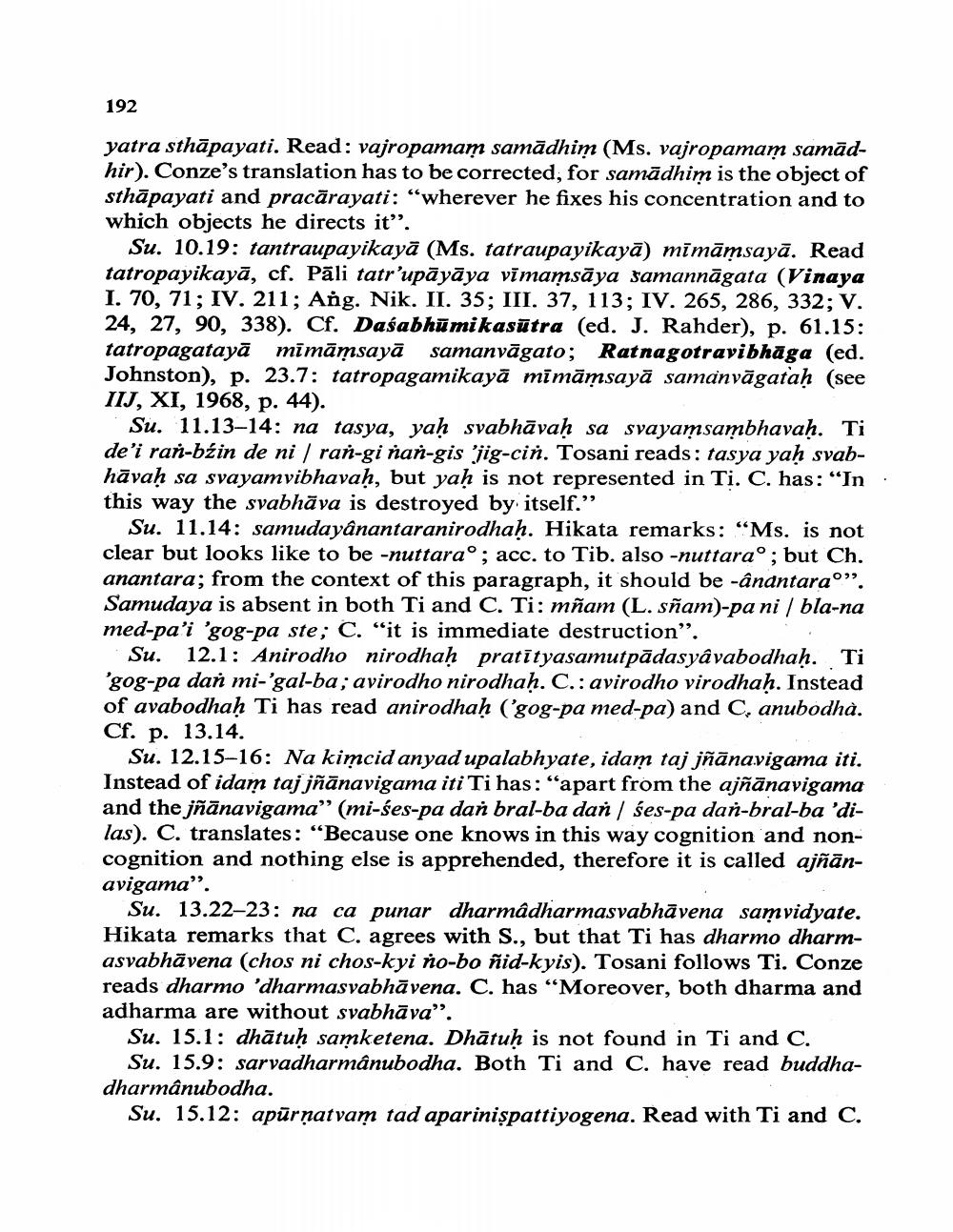Book Title: Notes On Prajnaparamita Texts Author(s): J W De Jong Publisher: J W De Jong View full book textPage 6
________________ 192 yatra sthāpayati. Read: vajropamam samādhim (Ms. vajropamam samādhir). Conze's translation has to be corrected, for samādhim is the object of sthāpayati and pracārayati: "wherever he fixes his concentration and to which objects he directs it”. Su. 10.19: tantraupayikayā (Ms. tatraupayikayā) mīmāmsayā. Read tatropayikaya, cf. Pāli tatroupāyāya vinamsāya tamannagata (Vinaya I. 70, 71; IV. 211; Ang. Nik. II. 35; III. 37, 113; IV. 265, 286, 332; V. 24, 27, 90, 338). Cf. Dasabhūmikasūtra (ed. J. Rahder), p. 61.15: tatropagatayā mīmāmsayā samanvāgato; Ratnagotravibhāga (ed. Johnston), p. 23.7: tatropagamikayā mīmāmsayā samanvāgataḥ (see IIJ, XI, 1968, p. 44). Su. 11.13–14: na tasya, yaḥ svabhāvaḥ sa svayamsambhavaḥ. Ti de'i ran-bzin de ni / ran-gi nan-gis "jig-cin. Tosani reads: tasya yah svabhāvaḥ sa svayamvibhavaḥ, but yaḥ is not represented in Ti. C. has: "In this way the svabhāva is destroyed by itself.” Su. 11.14: samudayânantaranirodhaḥ. Hikata remarks: "Ms. is not clear but looks like to be -nuttarao; acc. to Tib. also -nuttarao; but Ch. anantara; from the context of this paragraph, it should be -ândntarao". Samudaya is absent in both Ti and C. Ti: mñam (L. sñam)-pa ni / bla-na med-pa'i 'gog-pa ste; C. “it is immediate destruction". Su. 12.1: Anirodho nirodhaḥ pratītyasamutpādas yâvabodhaḥ. Ti 'gog-pa dan mi-'gal-ba; avirodho nirodhaḥ. C.: avirodho virodhaḥ. Instead of avabodhaḥ Ti has read anirodhaḥ ('gog-pa med-pa) and C, anubodhà. Cf. p. 13.14. Su. 12.15-16: Na kimcid anyad upalabhyate, idam taj jñānavigama iti. Instead of idam taj jñānavigama iti Ti has: "apart from the ajñānavigama and the jñānavigama” (mi-ses-pa dan bral-ba dan / ses-pa dan-bral-ba 'dilas). C. translates: "Because one knows in this way cognition and noncognition and nothing else is apprehended, therefore it is called ajñānavigama”. Su. 13.22–23: na ca punar dharmâdharmasvabhāvena samvidyate. Hikata remarks that C. agrees with S., but that Ti has dharmo dharmasvabhāvena (chos ni chos-kyi no-bo ñid-kyis). Tosani follows Ti. Conze reads dharmo 'dharmasvabhāvena. C. has "Moreover, both dharma and adharma are without svabhāva". Su. 15.1: dhātuh samketena. Dhātuh is not found in Ti and C. Su. 15.9: sarvadharmânubodha. Both Ti and C. have read buddhadharmânubodha. Su. 15.12: apürnatyam tad aparinişpattiyogena. Read with Ti and C.Page Navigation
1 ... 4 5 6 7 8 9 10 11 12 13
